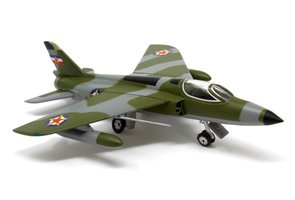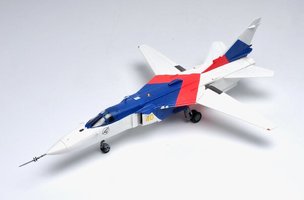Messerschmitt Me 262 A-1A, Germany 1945
| Model manufacturer: | Corgi |
| Order code: | COCAA35711 |
| Scale: | 1:72 |
| Material: | Combined (Metal / Plastic) |
| EAN: | 5063129006600 |
| Weight: | 0.8 kg |
| Registration number: | 17+ |
| Dimensions: | 15×17×6 cm (L×W×H) |
| Air company: | Germany Army |
| Aircraft manufacturer: | Messerschmitt |
Product description
High-quality metal model of the military aircraft Messerschmitt Me 262 A-1A, Germany 1945 in a limited edition. It is a detailed and precisely processed model of a World War II aircraft owned by the German army. The model package includes a stand and a limited collector's card.
The Messerschmitt Me 262 Schwalbe ("Swallow") was a German Messerschmitt aircraft manufactured at the end of World War II. It was the first mass-produced jet to see combat. After the war, the machine was further produced in Czechoslovakia under the designation Avia S-92.
Development of the Me 262 began before the Second World War in 1938. In 1941, the first tests took place without jet engines. Instead, one Jumo 210 piston engine was installed in the aircraft. This version was designated Me 262V1. The second version of the Me 262V2 was already equipped with jet engines, but for safety reasons, the designers left the piston engine in the aircraft. It paid off after both jet engines failed and the plane landed with a piston engine. The third V3 prototype had only BMW 003 jet engines and took off on July 18, 1942 in Leipheim near Günzburg. It was piloted by Fritz Wendel. The unreliable BMW 003 engines were replaced by Jumo 004 engines. The V5 version no longer had a spur wheel. Test flights lasted another year, but there were problems with the engines and then with Hitler, who stubbornly and unrealistically insisted on building a fast bomber (Blitzbomber).
The first engines had a prescribed service life of 50 hours, but many ended after only 12 hours of deployment. The main problem was the turbine blades. The designers had no experience with the behavior of materials at such high temperatures. Their so-called spreading, i.e. deformations, took place. By doing so, they affected the overall life of the engine. The disadvantage was also the low speed at lower thrust, which made the plane very vulnerable when landing. There were also problems with the chassis and armament.
A more significant advance came in 1943, when the aircraft was piloted by Luftwaffe ace Adolf Galland, who immediately began negotiations with the Luftwaffe for serial production. This first production version of the A-1 began production on July 30, 1943 in Regensburg, but due to Allied air raids on Regensburg, production had to be moved to Bavaria. It resumed production on November 30, 1943.

























